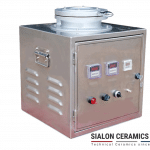Description
Hydrogen Content Analyzer Molten Copper

Our new hydrogen detection analyser for copper melts is the solution for your foundry to effectively determine the quality of the copper melt by means of the reduction pressure test (RPT). It is the best option also during ultrasonic degassing and ultrasonic grain refinement of molten aluminum.
Why is the Hydrogen detection analyser important in a copper foundry or cast house?
Hydrogen forms whenever molten copper comes into contact with water vapour, and easily dissolves into the melt. The gas tends to come out of the solution and forms bubbles when the melt solidifies.
The detrimental effects arising from the presence of an excess of dissolved hydrogen in copper are numerous.
Hydrogen causes porosity in copper products leading to many casting defects, reduced mechanical properties like fatigue and lower corrosion resistance. Several methods are used to reduce the amount of dissolved hydrogen from the melt, such as furnace fluxing prior to the casting process or using in-line degassing equipment during the casting process.











